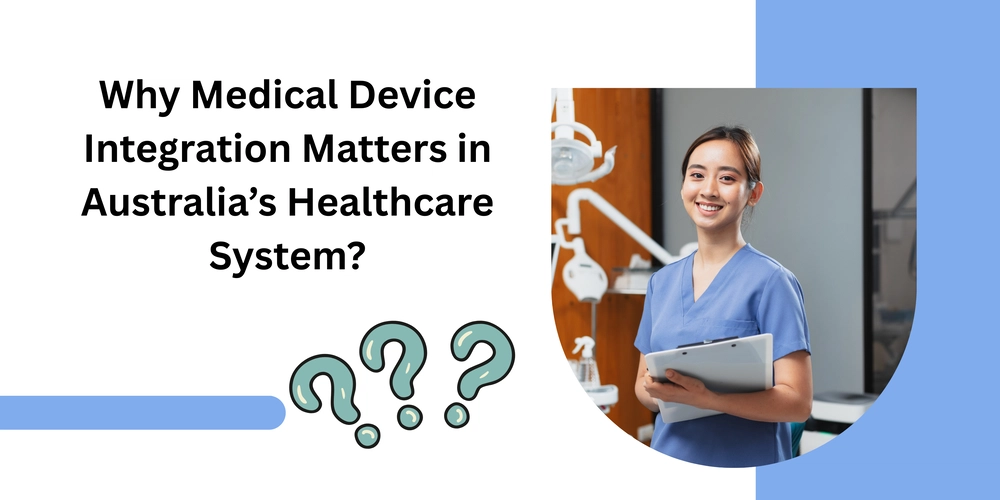Why Medical Device Integration Matters in Australia’s Healthcare System?
Introduction Australia’s healthcare system is rapidly evolving. From telehealth services to smart hospital systems, technology is playing a bigger role than ever. One of the most important changes happening in hospitals, clinics, and aged care centres is medical device integration (MDI). But what exactly is medical device integration, and why does it matter so much to the Australian healthcare sector? In this blog, I will be explaining MDI in simple terms, show how it benefits healthcare providers and patients in Australia, and help you understand why now is the right time to invest in integrated medical device systems. What is Medical Device Integration? Medical Device Integration means connecting various medical devices—like heart rate monitors, ventilators, infusion pumps, and imaging systems—with hospital information systems (HIS), Electronic Health Records (EHR), and other digital healthcare platforms. It allows real-time data sharing between devices and systems. This eliminates the need for manual data entry, reduces human error, and improves overall patient care. In simple terms, it's like making sure all the smart machines in a hospital can “talk” to each other and share important health information instantly. Why Medical Device Integration is Crucial in Australia? Australia faces a few key healthcare challenges that make MDI especially important: • Aging population: With more elderly people needing constant monitoring, MDI helps aged care centres and hospitals provide accurate, timely care. • Remote communities: In rural and remote parts of Australia, MDI supports telehealth by sending real-time patient data to distant doctors. • Staff shortages: With fewer healthcare workers, automation and integration reduce the burden of paperwork and manual updates. Key Benefits of Medical Device Integration in Australia 1. Improved Patient Safety Integrated devices reduce the chances of errors caused by manually entering patient data. For example, when a nurse connects a patient's blood pressure monitor to the hospital’s central system, the data is automatically recorded without mistakes. 2. Real-Time Monitoring Doctors and nurses can monitor a patient’s vital signs in real-time, no matter where they are. This is especially helpful in ICU and aged care facilities across Australia. 3. Faster Diagnosis and Treatment When data flows quickly from devices to doctors, they can make faster decisions. Time is critical in emergencies, and MDI saves those precious minutes. 4. Better Workflow Efficiency Automation reduces repetitive tasks like manual data entry, letting doctors and nurses focus more on patient care. 5. Seamless Data Storage and Access All device data gets stored securely and can be accessed easily later. This makes it easier to review a patient’s medical history and plan better treatments. How Fortunesoft Helps with Medical Device Integration? If you’re a healthcare provider in Australia, Fortunesoft offers expert solutions to help with integrating your medical devices. They focus on: • Device interoperability (connecting different types of devices, even from different brands) • Data standardization (so all systems understand the data in the same format) • Secure data transmission (using HIPAA-compliant and HL7/FHIR standards) • Custom integration platforms that fit your specific hospital or clinic needs Their team builds cloud-based, scalable, and secure solutions to ensure your devices connect easily with your hospital systems, without disruptions. Industry Use Cases in Australia 1. Hospitals in Major Cities Large hospitals in Sydney, Melbourne, and Brisbane are moving towards smart infrastructure. MDI allows smooth functioning of ICUs and operation theatres, with real-time data access and automatic updates to EHR systems. 2. Aged Care Homes In aged care centres across Australia, MDI helps caregivers track vital signs, manage medication, and send alerts in case of emergencies. 3. Remote Clinics Medical facilities in rural Queensland or Western Australia can use MDI to transmit patient data to larger hospitals for diagnosis and consultation. Compliance and Data Security Data privacy is a serious issue in Australian healthcare. Fortunesoft’s medical device integration solutions follow: • Australian Privacy Principles (APPs) • HL7 and FHIR protocols • ISO 13485 standards for medical software These ensure that patient data remains secure and compliant with government healthcare regulations. Conclusion Medical device integration is no longer just an upgrade—it’s a necessity for modern healthcare in Australia. By connecting all your healthcare devices to a single, secure platform, you save time, reduce errors, improve patient safety, and streamline operations. Whether you manage a hospital, aged care centre, or remote clinic, integrated solutions make a big difference. If you’re ready to make your healthcare facili

Introduction
Australia’s healthcare system is rapidly evolving. From telehealth services to smart hospital systems, technology is playing a bigger role than ever. One of the most important changes happening in hospitals, clinics, and aged care centres is medical device integration (MDI).
But what exactly is medical device integration, and why does it matter so much to the Australian healthcare sector?
In this blog, I will be explaining MDI in simple terms, show how it benefits healthcare providers and patients in Australia, and help you understand why now is the right time to invest in integrated medical device systems.
What is Medical Device Integration?
Medical Device Integration means connecting various medical devices—like heart rate monitors, ventilators, infusion pumps, and imaging systems—with hospital information systems (HIS), Electronic Health Records (EHR), and other digital healthcare platforms.
It allows real-time data sharing between devices and systems. This eliminates the need for manual data entry, reduces human error, and improves overall patient care.
In simple terms, it's like making sure all the smart machines in a hospital can “talk” to each other and share important health information instantly.
Why Medical Device Integration is Crucial in Australia?
Australia faces a few key healthcare challenges that make MDI especially important:
• Aging population: With more elderly people needing constant monitoring, MDI helps aged care centres and hospitals provide accurate, timely care.
• Remote communities: In rural and remote parts of Australia, MDI supports telehealth by sending real-time patient data to distant doctors.
• Staff shortages: With fewer healthcare workers, automation and integration reduce the burden of paperwork and manual updates.
Key Benefits of Medical Device Integration in Australia
1. Improved Patient Safety
Integrated devices reduce the chances of errors caused by manually entering patient data. For example, when a nurse connects a patient's blood pressure monitor to the hospital’s central system, the data is automatically recorded without mistakes.
2. Real-Time Monitoring
Doctors and nurses can monitor a patient’s vital signs in real-time, no matter where they are. This is especially helpful in ICU and aged care facilities across Australia.
3. Faster Diagnosis and Treatment
When data flows quickly from devices to doctors, they can make faster decisions. Time is critical in emergencies, and MDI saves those precious minutes.
4. Better Workflow Efficiency
Automation reduces repetitive tasks like manual data entry, letting doctors and nurses focus more on patient care.
5. Seamless Data Storage and Access
All device data gets stored securely and can be accessed easily later. This makes it easier to review a patient’s medical history and plan better treatments.
How Fortunesoft Helps with Medical Device Integration?
If you’re a healthcare provider in Australia, Fortunesoft offers expert solutions to help with integrating your medical devices. They focus on:
• Device interoperability (connecting different types of devices, even from different brands)
• Data standardization (so all systems understand the data in the same format)
• Secure data transmission (using HIPAA-compliant and HL7/FHIR standards)
• Custom integration platforms that fit your specific hospital or clinic needs
Their team builds cloud-based, scalable, and secure solutions to ensure your devices connect easily with your hospital systems, without disruptions.
Industry Use Cases in Australia
1. Hospitals in Major Cities
Large hospitals in Sydney, Melbourne, and Brisbane are moving towards smart infrastructure. MDI allows smooth functioning of ICUs and operation theatres, with real-time data access and automatic updates to EHR systems.
2. Aged Care Homes
In aged care centres across Australia, MDI helps caregivers track vital signs, manage medication, and send alerts in case of emergencies.
3. Remote Clinics
Medical facilities in rural Queensland or Western Australia can use MDI to transmit patient data to larger hospitals for diagnosis and consultation.
Compliance and Data Security
Data privacy is a serious issue in Australian healthcare. Fortunesoft’s medical device integration solutions follow:
• Australian Privacy Principles (APPs)
• HL7 and FHIR protocols
• ISO 13485 standards for medical software
These ensure that patient data remains secure and compliant with government healthcare regulations.
Conclusion
Medical device integration is no longer just an upgrade—it’s a necessity for modern healthcare in Australia.
By connecting all your healthcare devices to a single, secure platform, you save time, reduce errors, improve patient safety, and streamline operations. Whether you manage a hospital, aged care centre, or remote clinic, integrated solutions make a big difference.
If you’re ready to make your healthcare facility smarter, safer, and more efficient, Fortunesoft is here to help with custom medical device integration solutions tailored for Australia’s healthcare environment.
FAQs
1. What types of medical devices can be integrated?
Devices like ECG machines, ventilators, infusion pumps, pulse oximeters, CT scanners, and more can be integrated with hospital systems.
2. Is medical device integration expensive?
Costs vary based on the size of your facility and the types of devices. However, the long-term savings from efficiency and fewer errors make it a worthwhile investment.
3. Is the data secure after integration?
Yes. Reputed providers like Fortunesoft ensure all integrations follow strict security and compliance rules, including HIPAA and Australian regulations.
4. Can existing devices be integrated or do we need new ones?
Many existing devices can be integrated with the right middleware. You don’t always need to replace your equipment.
5. How long does integration take?
It depends on your system's size, number of devices, and complexity. Small facilities may complete integration in weeks, while larger hospitals might take a few months.




























![[Webinar] AI Is Already Inside Your SaaS Stack — Learn How to Prevent the Next Silent Breach](https://blogger.googleusercontent.com/img/b/R29vZ2xl/AVvXsEiOWn65wd33dg2uO99NrtKbpYLfcepwOLidQDMls0HXKlA91k6HURluRA4WXgJRAZldEe1VReMQZyyYt1PgnoAn5JPpILsWlXIzmrBSs_TBoyPwO7hZrWouBg2-O3mdeoeSGY-l9_bsZB7vbpKjTSvG93zNytjxgTaMPqo9iq9Z5pGa05CJOs9uXpwHFT4/s1600/ai-cyber.jpg?#)














































































































































![[The AI Show Episode 144]: ChatGPT’s New Memory, Shopify CEO’s Leaked “AI First” Memo, Google Cloud Next Releases, o3 and o4-mini Coming Soon & Llama 4’s Rocky Launch](https://www.marketingaiinstitute.com/hubfs/ep%20144%20cover.png)




































































































































































































![Rogue Company Elite tier list of best characters [April 2025]](https://media.pocketgamer.com/artwork/na-33136-1657102075/rogue-company-ios-android-tier-cover.jpg?#)








































































_Andreas_Prott_Alamy.jpg?width=1280&auto=webp&quality=80&disable=upscale#)



























































































![What’s new in Android’s April 2025 Google System Updates [U: 4/18]](https://i0.wp.com/9to5google.com/wp-content/uploads/sites/4/2025/01/google-play-services-3.jpg?resize=1200%2C628&quality=82&strip=all&ssl=1)










![Apple Watch Series 10 Back On Sale for $299! [Lowest Price Ever]](https://www.iclarified.com/images/news/96657/96657/96657-640.jpg)
![EU Postpones Apple App Store Fines Amid Tariff Negotiations [Report]](https://www.iclarified.com/images/news/97068/97068/97068-640.jpg)
![Apple Slips to Fifth in China's Smartphone Market with 9% Decline [Report]](https://www.iclarified.com/images/news/97065/97065/97065-640.jpg)



































































































































